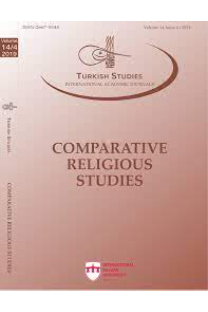Searches for Turkish Religion and Culture in the Foundation Period of the Republic
After the Ottoman Empire, the Republic of Turkey was tried to be established by building a new social order. During the establishment of this order, it is seen that an intense religious and cultural search for the past has been entered into. In this context, an intensive study has been carried out on the cultural characteristics of the Turks in a wide area including the regions with which Asia is connected and even the Chinese culture. It is aimed to determine the cultural, social, religious and other ties from these regions to Anatolian lands. So that, on the other hand it is thought that there are religious, linguistic and cultural similarities between Anatolian civilizations and Turks. For this reason, an intense archaeological activity has been undertaken in Anatolia. In particular, a proximity has been established between the Sumerian and Hittite civilizations and the Turks, In this way many materials has been obtained for the construction of national identity on the basis of having a deep-rooted civilization and history in the traces of archaeological remains. The studies have been carried out with the direct support of the state. Through the process, studies on the determination of the old beliefs of the Turks are very interesting. There have been important studies on the Central Asian roots of current religious belief and culture, and which beliefs the Turks had before Islam. Mustafa Kemal was also closely interested in the subject. In particular, research has been conducted in which shamanism was introduced as the ancient religion of the Turks. Some intellectuals and writers of the period claimed that the old religion of the Turks was Shamanism. Even today, research is being done on this subject. Evaluating all the studies and claims, Hikmet Tanyu has stated that the Turks had the belief in the Sky God before Islam. In the first years of the Republic of Turkey, the fields of archeology, anthropology, folklore and the history of religions have been profited by a lot on the relationship of the Turks with religion and past cultures. In this study, an evaluation of the searches in the field will be made based on mentioned approaches. The main purpose of the study is to understand that an evaluation is made on religion and culture in the newly established Republic of Turkey. In addition, it is seen that there is a desire for reform in the religious field and even some searches are carried out. Along with all these, the studies of the period were examined in depth with a descriptive method. The interest in the past of the Turks is based on the identification of cultural
___
- Açıkel, A. (2001). XIV-XVI. Yüzyıllarda Tokat zaviyeleri. İçinde Pax Ottomana studies in memoriam Prof. Dr. Nejat Göyünç (s. 13). Yeni Türkiye Yayınları.
- Açıkel, A. (2012). Tokat. İçinde Türkiye Diyanet Vakfı İslâm Ansiklopedisi (C. 41, ss. 219-223). TDV Yayınları.
- Açıkel, A. (2017). Osmanlı döneminde Tokat kazasında ahiler ve ahi zaviyeleri, I. Uluslararası ahilik kültürü ve Kırşehir sempozyumu, 1-21.
- Akgündüz, A. (1996). İslâm hukukunda ve Osmanlı tatbikatında vakıf müessesesi. Osmanlı Araştırmalar Vakfı.
- Güvemli, O & Güvemli, B. (2016). Osmanlı kayıt kültüründe vakıf muhasebesi ve devlet muhasebe sistemi, Vakıflar Dergisi, 46(9).
- https://kulturportali.gov.tr/turkiye/tokat/kulturenvanteri/ahi-pasa-mescidi-ve-kabri Kara, M. (2017). Tekke ve zaviyeler, Dergâh Yayınları.
- Numan, İ. (1985). İlk devir Türk sufi merkezlerinin mahiyetleri ve mimarilerinin menşei hakkında, Vakıflar Dergisi, 19, 31-48.
- Okudan, M. (2017). Osmanlı dönemi Samsun vakıfları. Erol Ofset.
- Okudan, M. (2019). Tokat Halef Sultan Hankahı Vakfı (H.691/1321), Dergiabant, 13, 133-148.
- Okudan, M. (2019). Tokat Ebu Şems (Vezir Ahmed Paşa) Zaviyesi Vakfı, BUİFD, 13, 169-184.
- Osmanlı Arşivi. İbnülemin Tasnifi Evkaf (BOA. İE. EV.), 12/1421; 56/61.
- Osmanlı Arşivi. Cevdet Tasnifi Evkaf (BOA. C. EV.), 207/10306.
- Osmanlı Arşivi. Ali Emiri Tasnifi III. Ahmed (BOA, AE. SAMDIII.), 85/8509.
- Özcan, Görgün. (2017). Osmanlı şehirciliği ve vakıflar, Yeditepe Yayınları.
- Özgen, Mutlu. (2017). Şehr-i meydan Tokat, Gece Kitaplığı.
- Sivas Vakıflar Bölge Müdürlüğü Arşivi. 1918 yılı Muhasebe Defteri, nr. 9, s. 296.
- Tokat Vakıflar Bölge Müdürlüğü Arşivi. 1874 yılı Muhasebe Defteri, nr. 1, s. 52-53.
- Tokat Şer’iyye Sicil Defteri (TŞSD), Defter nr. 53, V. 188, 190.
- Üstek, F. (1985). Tokat merkez kazası vakıf kayıtları: H. 984 (M. 1576) tarihli defter-i evkaf-ı Rum’a göre. Gazi Üniversitesi.
- Vakıflar Genel Müdürlüğü Arşivi. Defter No. 611, Sayfa no. 93, Sıra no. 79.
- Yediyıldız, B. (2012). Vakıf. İçinde Türkiye Diyanet Vakfı İslâm Ansiklopedisi (C. 42, ss. 479- 486). TDV Yayınları.
- Yediyıldız, B. (2003). XVIII. yüzyılda Türkiye’de vakıf müessesesi: bir sosyal tarih incelemesi. Türk Tarih Kurumu.
- ISSN: 2667-5544
- Yayın Aralığı: Yılda 4 Sayı
- Başlangıç: 2006
- Yayıncı: ASOS Eğitim Bilişim Danışmanlık Otomasyon Yayıncılık Reklam Sanayi ve Ticaret LTD ŞTİ
Sayıdaki Diğer Makaleler
Şiirleri ve Psikolojik Tahliller Çerçevesinde Zemahşerî’nin Hayatı
Searches for Turkish Religion and Culture in the Foundation Period of the Republic
Tokat Ahi Pasha Complex and Its Economic Structure in the XIX Century
The Big Bang Theory in Terms of Scientific Concise Expression of the Qur’an
Modern Sonrası Çağdaş Dönem Teolojisi Üzerine Bir Değerlendirme
Okuyucunun Allah’ın Kitabını Tefsir Etmedeki Sınırı
Ergenlik Çağındaki Öğrencilerde Değerler Sisteminin Oluşum Ortamı Olarak Aile ve Okul
Cumhuriyetin Kuruluş Yıllarında Türk Dini ve Kültürüne Yönelik Arayışlar
Affân b. Muslimin Hadis Rivayet Üslubu ve Mihnesi Hakkında Bir Değerlendirme
al-Zamakhsharī’s Life in the Frame of her Poems and Psychological Analysis
